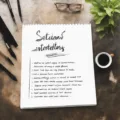Mindfulness and meditation have become increasingly popular practices for enhancing mental well-being and overall health. Whether you’re new to these concepts or looking to deepen your practice, these nine steps and tips will guide you on your journey.
1. Understand the Basics of Mindfulness and Meditation
Before diving into the practice, it’s essential to understand what mindfulness and meditation are. Mindfulness involves being fully present and engaged in the current moment, while meditation is a practice where an individual uses techniques such as mindfulness to achieve a mentally clear and emotionally calm state.
2. Set Clear Intentions
Set specific goals for your mindfulness and meditation practice. Whether you aim to reduce stress, improve focus, or enhance emotional health, having clear intentions will help you stay motivated and consistent.
3. Create a Comfortable Space
Find a quiet and comfortable space where you can practice without interruptions. This space should be free from distractions and should make you feel relaxed and at ease.
4. Start with Short Sessions
If you’re new to mindfulness and meditation, start with short sessions of 5-10 minutes. Gradually increase the duration as you become more comfortable with the practice.
5. Focus on Your Breath
One of the simplest ways to practice mindfulness is to focus on your breathing. Pay attention to the sensation of your breath as it enters and leaves your body. This can help anchor you in the present moment.
6. Use Guided Meditations
Guided meditations can be a great way to start your practice. There are numerous apps and online resources that offer free guided meditation sessions, which can help you stay focused and provide structure to your practice.
7. Incorporate Mindfulness into Daily Activities
Mindfulness doesn’t have to be limited to formal meditation sessions. Incorporate mindfulness into your daily activities, such as eating, walking, or even washing dishes. Pay full attention to the sensations and experiences of these activities.
8. Be Patient and Kind to Yourself
Mindfulness and meditation are skills that take time to develop. Be patient with yourself and acknowledge that it’s normal for your mind to wander. Gently bring your focus back to the present moment without judgment.
9. Keep a Journal
Keep a mindfulness journal to track your progress and reflect on your experiences. Writing down your thoughts and feelings can help you understand your practice better and identify areas for improvement.
FAQ
1. What is the best time of day to practice mindfulness and meditation?
There is no single best time to practice mindfulness and meditation; it varies from person to person. Some people prefer mornings to start their day with clarity, while others find evenings a good time to unwind. Choose a time that fits your schedule and allows you to practice consistently.
2. How long should I meditate each day?
The duration of your meditation practice can vary based on your experience and goals. Beginners might start with 5-10 minutes daily and gradually increase to 20-30 minutes as they become more comfortable. The key is consistency rather than duration.
3. Can mindfulness and meditation help with anxiety?
Yes, mindfulness and meditation have been shown to reduce symptoms of anxiety. By helping individuals focus on the present moment and manage their thoughts more effectively, these practices can provide relief from anxious feelings.
4. Do I need any special equipment to practice mindfulness and meditation?
No special equipment is required to practice mindfulness and meditation. All you need is a quiet space and a willingness to focus. Some people find it helpful to use a meditation cushion or mat, but these are not necessary.
5. How can I stay motivated to practice mindfulness and meditation regularly?
Staying motivated can be challenging, but setting clear intentions, tracking your progress, and incorporating mindfulness into your daily routine can help. Joining a meditation group or using apps with reminders and guided sessions can also keep you on track.









